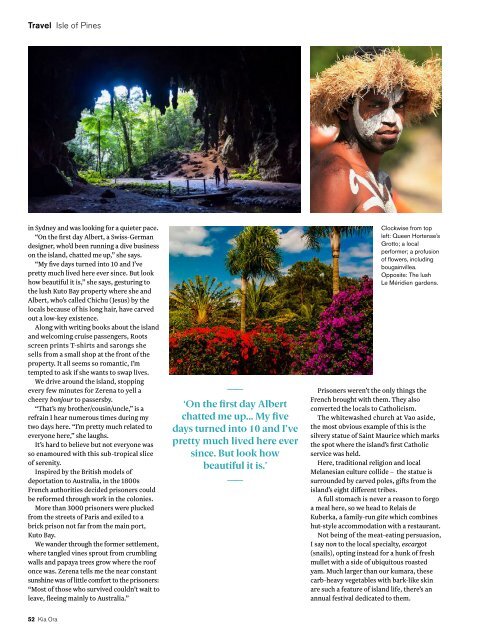Create successful ePaper yourself
Turn your PDF publications into a flip-book with our unique Google optimized e-Paper software.
Travel Isle of Pines<br />
in Sydney and was looking for a quieter pace.<br />
“On the first day Albert, a Swiss-German<br />
designer, who’d been running a dive business<br />
on the island, chatted me up,” she says.<br />
“My five days turned into 10 and I’ve<br />
pretty much lived here ever since. But look<br />
how beautiful it is,” she says, gesturing to<br />
the lush Kuto Bay property where she and<br />
Albert, who’s called Chichu (Jesus) by the<br />
locals because of his long hair, have carved<br />
out a low-key existence.<br />
Along with writing books about the island<br />
and welcoming cruise passengers, Roots<br />
screen prints T-shirts and sarongs she<br />
sells from a small shop at the front of the<br />
property. It all seems so romantic, I’m<br />
tempted to ask if she wants to swap lives.<br />
We drive around the island, stopping<br />
every few minutes for Zerena to yell a<br />
cheery bonjour to passersby.<br />
“That’s my brother/cousin/uncle,” is a<br />
refrain I hear numerous times during my<br />
two days here. “I’m pretty much related to<br />
everyone here,” she laughs.<br />
It’s hard to believe but not everyone was<br />
so enamoured with this sub-tropical slice<br />
of serenity.<br />
Inspired by the British models of<br />
deportation to Australia, in the 1800s<br />
French authorities decided prisoners could<br />
be reformed through work in the colonies.<br />
More than 3000 prisoners were plucked<br />
from the streets of Paris and exiled to a<br />
brick prison not far from the main port,<br />
Kuto Bay.<br />
We wander through the former settlement,<br />
where tangled vines sprout from crumbling<br />
walls and papaya trees grow where the roof<br />
once was. Zerena tells me the near constant<br />
sunshine was of little comfort to the prisoners:<br />
“Most of those who survived couldn’t wait to<br />
leave, fleeing mainly to Australia.”<br />
——<br />
‘On the first day Albert<br />
chatted me up... My five<br />
days turned into 10 and I’ve<br />
pretty much lived here ever<br />
since. But look how<br />
beautiful it is.’<br />
——<br />
Clockwise from top<br />
left: Queen Hortense’s<br />
Grotto; a local<br />
performer; a profusion<br />
of flowers, including<br />
bougainvillea.<br />
Opposite: The lush<br />
Le Méridien gardens.<br />
Prisoners weren’t the only things the<br />
French brought with them. They also<br />
converted the locals to Catholicism.<br />
The whitewashed church at Vao aside,<br />
the most obvious example of this is the<br />
silvery statue of Saint Maurice which marks<br />
the spot where the island’s first Catholic<br />
service was held.<br />
Here, traditional religion and local<br />
Melanesian culture collide – the statue is<br />
surrounded by carved poles, gifts from the<br />
island’s eight different tribes.<br />
A full stomach is never a reason to forgo<br />
a meal here, so we head to Relais de<br />
Kuberka, a family-run gite which combines<br />
hut-style accommodation with a restaurant.<br />
Not being of the meat-eating persuasion,<br />
I say non to the local specialty, escargot<br />
(snails), opting instead for a hunk of fresh<br />
mullet with a side of ubiquitous roasted<br />
yam. Much larger than our kumara, these<br />
carb-heavy vegetables with bark-like skin<br />
are such a feature of island life, there’s an<br />
annual festival dedicated to them.<br />
52 <strong>Kia</strong> <strong>Ora</strong> <strong>Sept</strong>ember 2017 53



